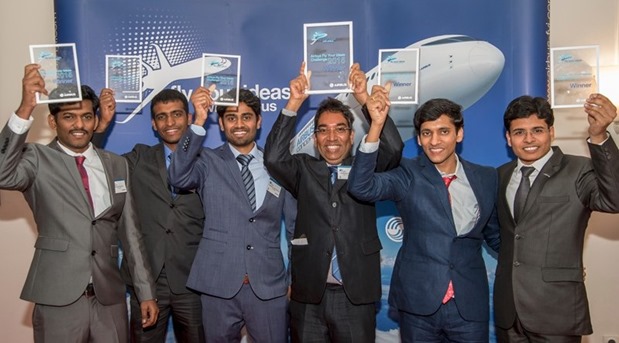Indian Students Harvest Energy From Vibrations of Aircraft Wings, Win Prestigious UNESCO Competition

5 Indian students, located at 5 different countries, worked virtually to create a model which can disrupt the aviation industry for ever.
They have successfully harvested energy from the natural vibrations of an aircraft wing, thereby winning 1st prize at the prestigious UNESCO-AIRBUS Fly Your Ideas Competition held in Hamburg, Germany. The winning team won €30,000 for their unique invention.
About The Competition
As of now, more than 15,000 students from more than 600 universities have participated in this biennial competition initiated by Airbus, wherein they are required to implement one idea which can transform the aviation industry, and instill a new paradigm of innovation aided with technology. Airbus started this competition in 2009.
For 2015 competition, total of 518 ‘multi-disciplinary’ teams submitted their projects by December, 2014, out of which 100 teams were selected representing 413 students from 48 countries. Out of these selected students, 45% were based in Asia-Pacific region, 35% in Europe and 15% in America. Interestingly, 50% of the winners of Round 1 were female students.
After rigorous examination, and several rounds, 8 teams from 13 countries were selected for the final round, which began in May, 2015. The panel of judges comprised of veterans from aviation industry, with representatives from major airlines. The panel was led by Charles Champion, Airbus Executive Vice President Engineering. The competition was supported by UNECSO.
The winning team comprising of Indian students was declared last week via press release.
The Indian Team: Team Multifun
5 Indian students formed a team which they called ‘Multifun’, and started working on an idea to harvest energy from the natural vibrations of an airplane wing. The team comprised of:
- Team Leader Satishkumar Anasuya Ponnusami, (M.Sc Aerospace Engineering , IISc), who is currently pursuing PhD at the Delft University of Technology, Netherlands
- Damotharan Veerasamy (M.Sc Aerospace Engineering, IISc), who is currently pursuing PhD at City University, London
- Shashank Agarwal and Ajith Moses, currently pursuing their PhDs at the Nonlinear Multifunctional Composite Analysis and Design (NMCAD) laboratory, Aerospace Engineering Department at IISc
- Mohit Gupta (Indian Academy of Sciences Fellow at the NMCAD lab at IISc), who is currently pursuing his M.S at Georgia Tech, USA
The team was mentored by Assistant Professor Dineshkumar Harursampath, from Aerospace Engineering Department at IISc.
As mentioned, all 5 members of this team were located at 5 different countries. Using communication tools such as Skype and other messengers, they collaborated 24*7, and worked on the idea simultaneously. They met for the first time during the last round of competition in Germany.
Modus Operandi
The team decided to understand the aero-dynamics of aircraft wings, which vibrate naturally during flight. The idea revolved around working on the wings’ composite skin which can harvest energy from these vibrations. Using Piezoelectric fibres, which can gather electrical charges from even the slightest vibration during a flight, they stored the energy generated in tiny battery panels which were integrated in fuselage.
This newly generated energy was later used to power auxiliary in-flight appliances such as lighting and entertainment systems. Further research revealed that these small bursts of energy can drastically reduce the energy footprint of any aircraft during a flight, thereby conserving energy on a larger scale. As per the panelists, such is the potential that this alternate form of energy can replace the entire power source, right from the ground operations to in-flight tasks.
Runners up team was from Sao Paulo, Brazil, which developed an interesting system to manage garbage generated during and flight, and an innovative strategy to quickly collect and dispose off the junk. They received cash prize of €15000.
You can get more information about this competition and the winning team’s incredible approach to solve a major aviation problem by visiting here.
